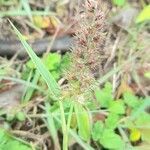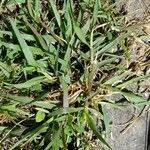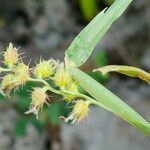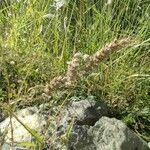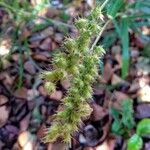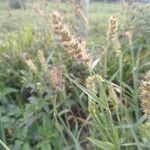Annual; culms erect to geniculate or decumbent-spreading, often rooting at the nodes, branching, as much as 1 m. long, glabrous; sheaths compressed, keeled, glabrous, or ciliate on the margins near the summit; ligule ciliate, 1 mm. long; blades mostly 6-20 cm. long, 3-8 mm. wide, acuminate, more or less pilose; spikes 3-10 cm. long, the axis rather stout, flexuous, scabrous; burs scarcely crowded, 4-7 cm. long, usually broader than long, pubescent, containing 3-6 spikelets, the bristles below the bur fewer and stouter than in C. bro'wnii, the lobes or spines erect to spreading, retrorsely barbed at the tip; spikelets 4.5-6 mm. long; first glume small, narrow, 1-nerved, the second two-thirds to three-fourths as long as the nearly equal fruit and sterile lemma; fruit acuminate, the nerves of the lemma apparent near the tip.
Annual, ascending from a geniculate base, 2–8 dm; lvs 4–25 cm × 4–10 mm; burs well spaced on a flexuous rachis, short-hairy, 5–10 × 3.5–6 mm, truncate at the base, the single row of coarse upper spines 2–5 mm, retrorsely scabrid, mostly erect, sometimes interlocking, those of the outer rows finer, half as long, more divergent or some of them reflexed; spikelets 2–3 per bur, 5–7.5 mm; 2n=34, 68. Sandy waste places and forest-margins; trop. Amer., n. to N.C. and even D.C.
Coarse annual; culms 15–90 cm. high, ascending.. Leaf-blades 4–25 cm. long, 3–10 mm. wide.. Panicle 2–10 cm. long; involucres globose, 5–10 mm. long; inner spines flattened, connate for ± 1/2 their length to form a deep cup, pubescent, retrorsely barbellate; outer spines rigid, mostly shorter than the inner, ± divergent.. Spikelets 2–3 per burr, 5–7 mm. long.
A grass. It grows each year from seed. It grows 25-60 cm tall. The lower part can lie along the ground and form roots at the nodes. The leaf blades are 5-30 cm long by 0.5-1 cm wide. The flowering shoots are 3-10 cm long. The flowers are in a dense spike. The seeds are 1.6-3.2 mm long by 1.3-2.2 mm wide.
Annual 30–90 cm. high.
Pending.
